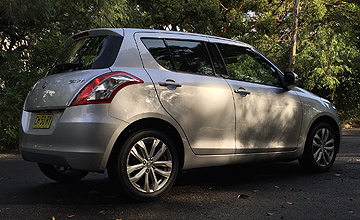BY DANIEL DEGASPERI | 8th Dec 2016

Suzuki has also leveraged the GL Navigator’s appeal with the relatively recent addition of 16-inch alloy wheels, which in addition to the continued presence of front foglights and mirror-mounted side indicators, makes for an attractive beyond-base option.
A leather-wrapped steering wheel with illuminated audio and cruise controls, in addition to the touchscreen unit, also ensures the cabin takes a step up from that found in an airport-rental carpark.
It takes jumping to the GLX to score single-zone climate control air-conditioning, keyless auto-entry and part-leather trim, but the $4500 surcharge for that top model is debatable value.
Although a four-speed automatic (as tested here) is a further $2000 option, keep in mind that Suzuki regularly throws it in for nix.
InteriorAlthough the original ‘reborn’ Swift of 2005 was produced in Japan, manufacturing has since switched to Thailand where Suzuki can take advantage of Australia’s free-trade agreement with that country. In terms of cabin quality and general fit-out, it matters nought with this model.
The Swift GL Navigator boasts a superb level of finish that clearly benefits from the inherent engineering standards that went into the second-generation model before it was launched in 2011.
Suzuki could learn from history here because, while its plastics are of the hard but textured variety typical of this price-sensitive segment, they are demonstrably superior to newer and more expensive models in the range such as the Baleno small hatchback and Vitara small SUV.
The touchscreen is easy to use, with iPod/USB and Bluetooth phone and audio connectivity pairing effortlessly, although the satellite navigation operates similarly to an aftermarket Navman-style unit. A more sizeable issue is a lack of reversing camera or parking sensors as standard.
Other subtle detailing such as the chrome-ringed speedometer and tachometer, chrome doorhandles and cloth-cloaked door trims (that many rivals leave as hard plastic) further leverage the Swift beyond most competitor offerings.
The cloth trim itself is high quality, and it wraps around among the broadest and most comfortable front seats in the class. The plushness does not transfer rearward, however, with the rear bench being hard and flat, while headroom and legroom are lacking.
The Swift is also one of the shortest cars in the class, which is a boon for parking at the shops but not for carrying shopping – the 210-litre volume is about one-third smaller than the most capacious vehicles in the light hatchback segment, the Honda Jazz and Renault Clio.
Engine and transmissionOn paper, the combination of a 1.4-litre four-cylinder engine and four-speed automatic transmission look as underdone as a steak without heat.
Unfortunately, small engines were always most in need of more ratios, which required greater investment in technology that modest pricetags could not sustain. It was a cruel equation, but thankfully, automatics have become more affordable so that even the Mazda2 can now be equipped with a six-speed self-shifter.
Surprisingly, however, Suzuki’s old auto is an adept operator. Sometimes the engine – with just 130Nm of torque at 4000rpm and 73kW of power at 6000rpm – gets caught between points on the tachometer without the auto having a ratio to fill the gap, but mostly the combination works effortlessly.
The 1.4-litre is not as sweet as the 2005 model’s revvy 1.5-litre, but it is refined enough and delivered an excellent 7.4 litres per 100 kilometres on test, despite a traffic-focused driving loop. The official combined cycle claim is 6.2L/100km.
Ride and handlingSuzuki clearly had one eye on the best European competition when it engineered this Swift. As with the interior, its efforts have held up well as it edges closer towards retirement.
Compared with the 2005 model, this 2011-era replacement still delivers a comfortable ride over patchy surfaces, yet it now adds substantial body control into the mix. The result is a great blend of plushness and discipline, supported by willing and engaging handling.
That said, the switch between generations from Bridgestone Potenza sports tyres to the Turanza touring units from the same brand probably highlights Suzuki’s intentions with this model.
The Swift is among the quietest vehicles in its segment from a road and wind noise perspective. What Suzuki cannot seem to get quite right is the electrically assisted steering calibration, which becomes heavy and lumpy when turning the tiller quickly during parking manoeuvres, right when lightness is most required.
Safety and servicingSeven airbags (including dual front, front-side, full-length curtain and driver’s knee protection), ABS and switchable electronic stability control (ESC).
ANCAP tested the Suzuki Swift in 2011 and it scored five stars with 35.55 out of 37 points.
Suzuki has a capped-price servicing program with intervals every six months or 10,000km, at a cost of $199 for the first three checks and $299 for the fourth – with those costs mirrored for the following four services.
VerdictSuzuki’s second-generation Swift has held up astoundingly well for a half-decade-old light hatchback.
More importantly, it can still be confidently recommended to a buyer looking for a simple, high-quality and trustworthy little car that is especially comfortable when travelling one-up thanks to great seat and suspension comfort and low noise intrusions.
Ultimately the newer Mazda2 is sportier and packs greater technology, while the Honda Jazz and Renault Clio are roomier, and all three boast more competitive automatic transmissions. Equally, however, that trio cannot quite blend virtues of enduring comfort and quality to the same degree, and that speaks volumes – even if the light car class cannot match the sales volumes of yesteryear.
RivalsHonda Jazz VTi-S from $19,790 plus on-road costsGreat pace and space, but suspension disappointing.
Mazda2 Maxx from $17,690 plus on-road costsSuperbly modern little hatch has zoom, lacks room.